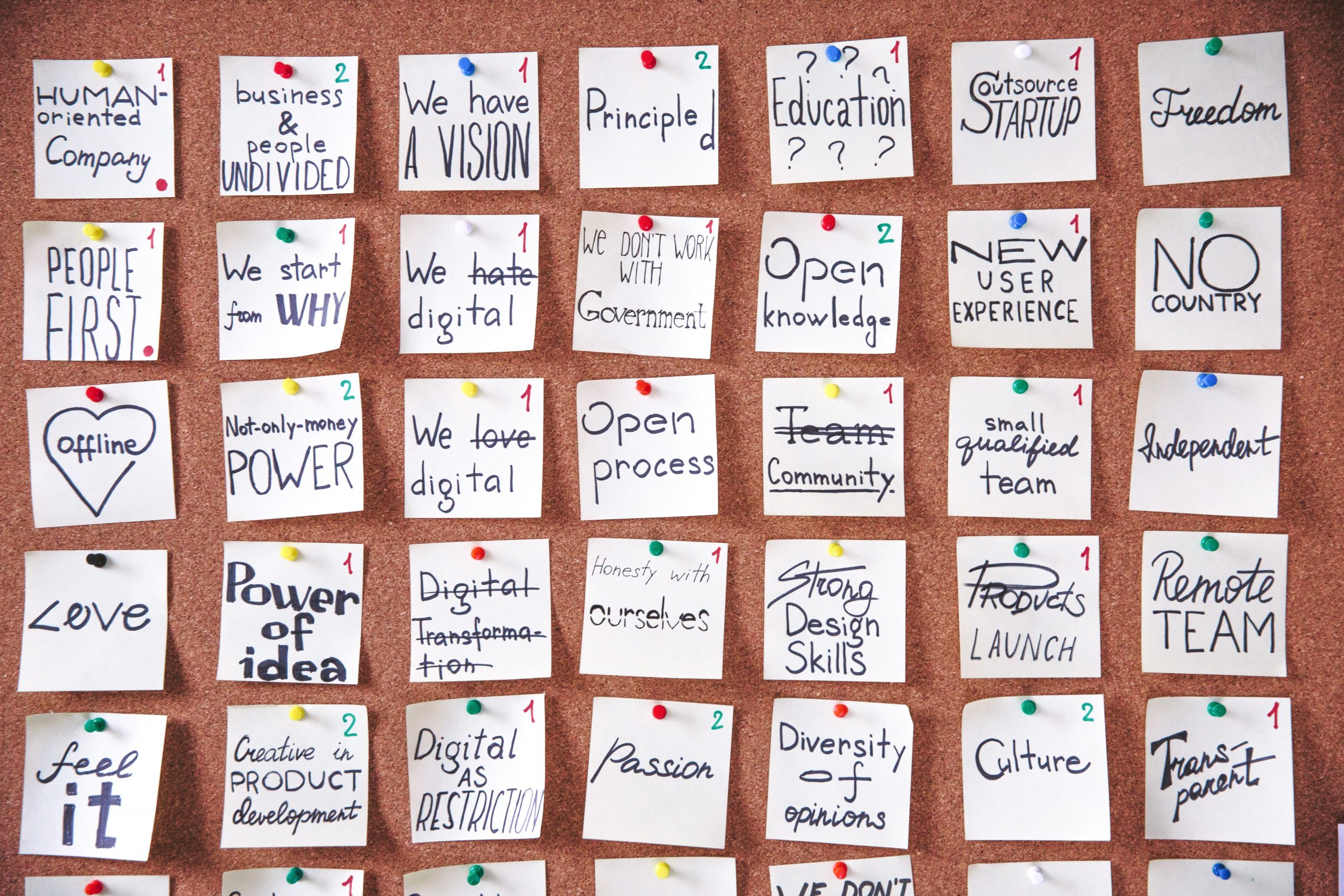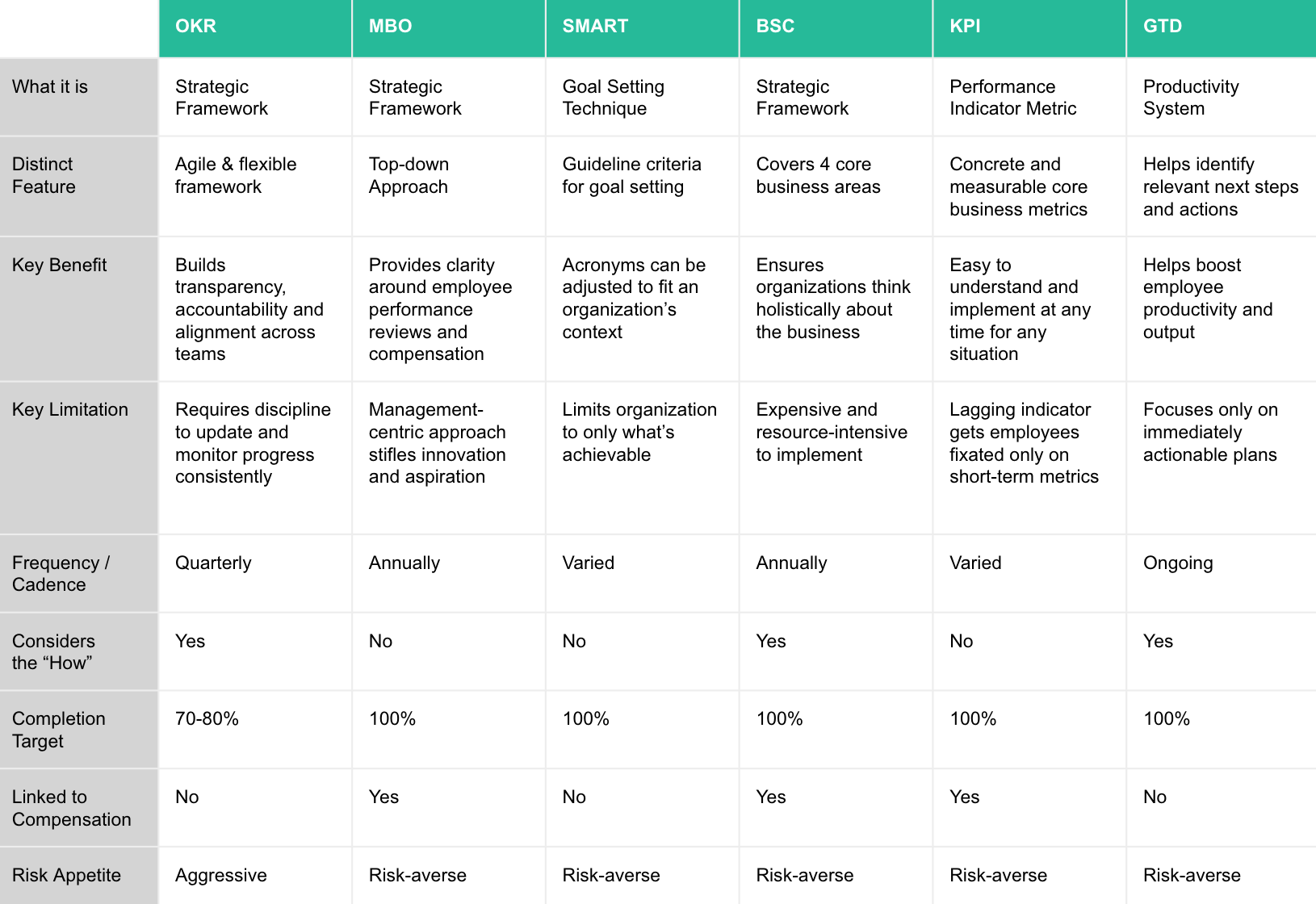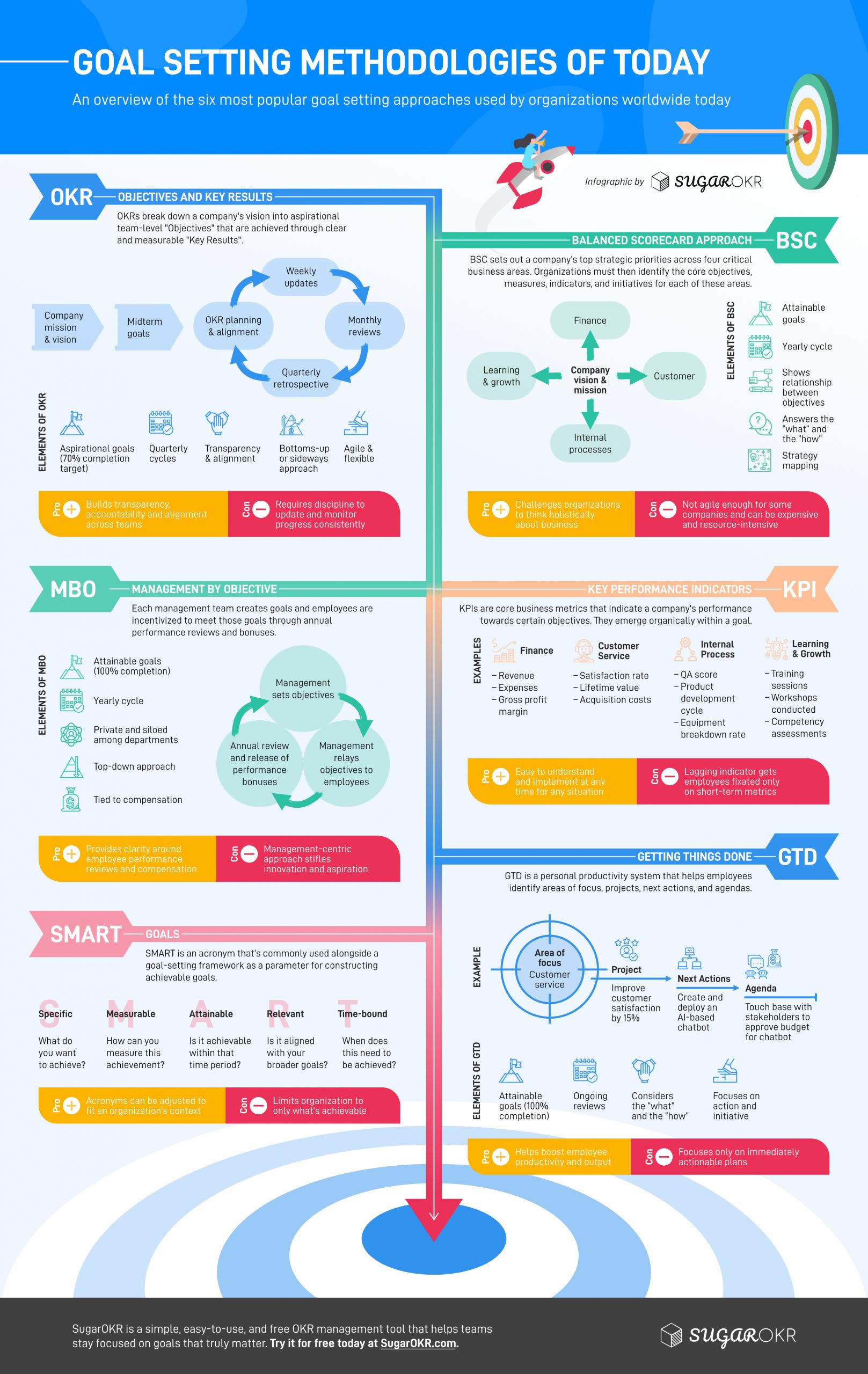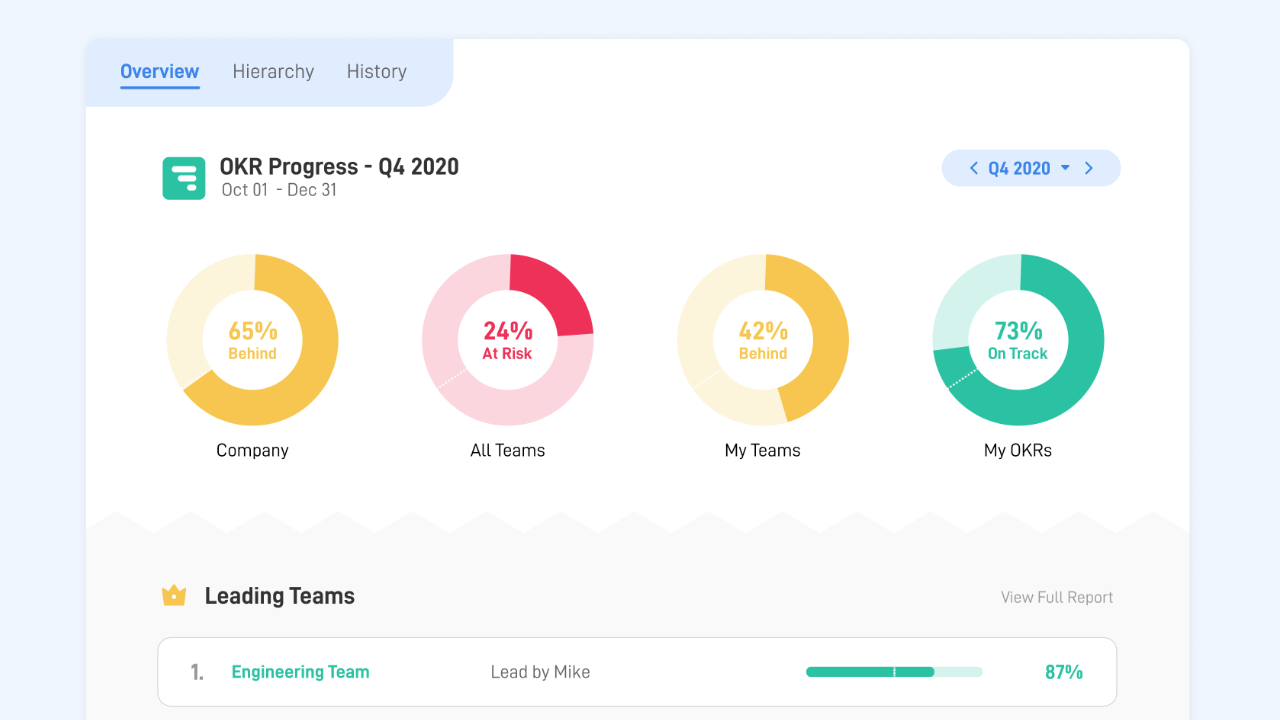OKR vs MBO vs SMART vs BSC vs KPI vs GTD. Enough to confuse you yet?
These are acronyms of popular goal setting methodologies used by organizations and teams all over the world today.
Goal setting is essential in an organization’s success. It helps businesses, from corporates to small and medium enterprises (SMEs), accelerate growth in an efficient and purposeful way. It also motivates employees and makes them feel aligned with the company. Without proper goal-setting, companies can easily lose sight of their purpose.
In this article (some readers call it a cheat sheet 🙂 ), we’ll touch on the 6 most popular goal setting methodologies. We’ll talk about what they are, their benefits and limitations, as well as examples of each of them. At the end of each methodology, we’ll compare it side-by-side with the popular OKR framework for better illustration. You’ll also see how different methodologies can even be used together.
Let’s begin!
Topics:
- Objectives & Key Results (OKR)
- Management By Objectives (MBO)
- SMART Goals
- Balanced Scorecard (BSC)
- Key Performance Indicators (KPI)
- Getting Things Done (GTD)
- Summary: Comparison Table
- Bonus: Infographic!

1. Objectives and Key Results (OKRs)
Objectives and Key Results (OKRs) is a goal setting framework introduced by Andrew Grove, former CEO of Intel, in the 1980s. He built upon an earlier methodology called Management By Objectives (MBO) – more on that later – and applied it to the core values of Intel, which resulted in the framework for OKRs as we know it today.
It grew in popularity when John Doerr, a former employee at Intel and early investor of Google, introduced the concept of setting OKRs to Larry Page and Sergey Brin.
Now, many Silicon Valley giants use it for their companies, including the Amazon, Netflix, Facebook, Twitter, Spotify, and LinkedIn.
What are OKRs?
OKRs break down strategy and execution into two parts: the Os (Objectives) and the KRs (Key Results).
- Objectives – These describe the high level goals that your company wants to achieve and sets the direction for your efforts.
- Key Results – These define the measurable outcome required to achieve an objective. Key Results consist of specific initiatives, which are projects and tasks that will help you achieve your Key Results.
Think of Objectives as the “what” in what you’re trying to achieve, and the Key Results as the “how” – how you should go about your quarter (initiatives) ensuring you hit your goals (measurable outcomes). If you need more inspiration, check out more OKR ideas here.
Implementing OKRs can be done at various levels in your organization. You can have a company-level OKR that’s based on the mission and vision of your entire business; department-level OKRs, which are more specific to the functions of each department; and team-level OKRs, which can be used for more specific projects.
Through this hierarchy of OKRs, you can ensure that each department and project is aligned with the organization’s ultimate vision.
There are three distinct characteristics of OKRs.
First, OKRs are implemented and evaluated typically on a quarterly basis, with weekly check-ins to make sure the business is on track. Everyone is privy to each department’s Objectives and aligned with why they are working towards certain goals.
Second, these Objectives are planned bi-directionally. Some call this a bottoms-up approach, but it also includes a bilateral approach to strategy making. Everyone in the team is involved in setting OKRs and initiatives (as opposed to just blindly taking orders from the top).
Third, achievability doesn’t matter – the loftier the goal, the better. OKRs push employees to go above and beyond what they can imagine being “easily achievable.” So even if they don’t meet their Objectives, they are still working towards a higher goal. Seventy percent completion is already considered a good (and recommended) result.
The benefits of OKRs
There are many benefits of OKRs. One of the framework’s biggest strengths is the flexibility and agility it offers. Most goal-setting methodologies are planned and reviewed annually, whereas OKRs are deployed on a quarterly basis (with weekly check-ins). This gives companies the flexibility to change or adjust their strategies according to the current landscape. This also keeps employees from getting stuck in the “set and forget” trap – instead, everyone is aligned with their goals and consistently striving towards new outcomes.
These Objectives also aren’t limited to what’s achievable or tied to performance reviews and compensation, which creates a culture wherein people are not afraid to set ambitious goals since there’s no pressure of failing. And because employees have the freedom to design their goals, they tend to be more engaged with achieving the Objectives.
The limitations of OKRs
The OKR framework allows a lot of flexibility. While this may sound like a good thing, it’s common for organizations and teams to misuse the framework, and turn it into something entirely different. For example, many people end up using OKRs as a personal to-do/task list without any alignment of goals across teams or departments. This totally misses the point of doing OKRs.
OKRs also require a certain level of discipline for an organization to extract its true value. This includes regular and timely status updating (of Key Results), as well as check-ins with managers (to monitor the progress of Objectives). This is important because you want to catch OKRs that are falling behind early enough and take appropriate action before it’s too late.
Example of an OKR
To give you a better idea of how a company might define goals through an OKR model, imagine that your business’s customer service department is looking to improve its performance. Here’s how your goals might look using the OKR framework:
| Objective | Key Results | Initiatives |
| Become the #1 fashion e-commerce retailer in Southeast Asia in terms of customer service | Resolve 20% more customer service queries than in 2020 | Create and deploy an AI-based chatbot |
| Reduce average customer call times by one minute | Host more training programs for the customer service team | |
| Decrease time-to-resolution of support tickets by 30% | Create more support channels for customers and support reps to communicate on |
Note: to highlight the differences between these goal-setting methods, we’ll be using this same example throughout this article.)

2. Management by Objectives (MBO)
Management by Objectives (MBO) is a strategic management framework made popular by management guru Peter Drucker in 1954 through his book, The Practice of Management. This model aims to improve the performance of an organization by clearly defining goals and objectives, and incentivizing the rest of the company to work towards those.
What are MBOs?
In the world of MBOs, the objectives are created by the management teams with the help of employees in a top-down approach. These objectives are meant to be challenging but achievable. They usually follow the SMART criteria (more on that later) and are planned for the long term.
Managers then relay these objectives to employees and offer appealing bonuses, benefits, or rewards to those who can meet these, typically after an annual review. These discussions are usually confidential, so only employees and their line managers are aware of their department’s objectives.
Once these employee objectives are in place, managers can use monitoring tools to keep up to date with the progress of the employees in meeting their goals. At the end of the year, managers will then review an employee’s performance and grant the relevant bonuses, if any.
This is also a good time to review past performance, assess how the team was able to reach that goal, and how they can continue to make progress in the coming years. Managers can give employees feedback on where they’ve excelled and what areas they can still improve on.
The benefits of MBOs
The good thing about MBOs is that they ushered in an era of results-oriented management and served as the foundation for many goal-setting methodologies today.
It offers clear indicators of success that everyone in the company can work towards. Employees take pride in working towards goals they can achieve, since these are aligned with their strengths, skills, and function, and are dutifully rewarded when they meet these expectations.
MBO also allows increased communication between managers and employees through performance reviews and collaborative efforts on goals.
The limitations of MBOs
There’s also been a lot of criticism against MBO in recent years, particularly in terms of cadence. Goals under MBO are set on an annual basis, sometimes even longer. This makes it difficult for companies that use MBO to adapt to today’s fast-paced landscape.
Goal-setting is also siloed, meaning each department is doing its own thing. While the goals and objectives set are supposed to be aligned with the company’s overarching vision, there’s no cohesive strategy governing the entire operation.
Critics also say that objectives are management-driven rather than people-driven, and tying goals to performance reviews and compensation puts an emphasis on the goal and not the means. In other words, employees can do anything to achieve these goals. And when employees are competing with one another for bonuses, it may result in “unwanted” behavior. This ignores other aspects of a thriving company, such as the culture of conduct or having a healthy work ethos.
Lastly, the idea of setting achievable goals underscores a sense of risk-aversion – it embeds a culture of meeting the minimum. It’s equivalent to saying, “this is the minimum I’m happy to commit to.”
Example of an MBO
Here’s how your goals might look using the MBO framework:
| Departmental Objective | Employee Objectives | Performance Bonus |
| Increase customer satisfaction by 15% in 2021 | Resolve 20% more customer service queries than in 2020 | 10% salary bonus |
| Reduce customer call times by one minute | 5% salary bonus | |
| Get 100 five-star satisfaction reviews from customers | 15% salary bonus |
On paper, some of these goals may look similar to how it would look using an OKR framework, but the difference lies in ambition, execution, and frequency.
OKR vs MBO
| OKR | MBO | |
| Frequency/Cadence | Quarterly | Annually |
| Considers the “how” | Yes | No |
| Completion target | 70% | 100% |
| Linked to compensation | No | Yes |
| Risk appetite | Aggressive | Risk-averse |

3. SMART
SMART is probably one of the most well-known goal-setting approaches used today because of how simple and actionable it is. It dates as far back as the 19th century and was introduced to organizations when George T. Doran published a paper titled “There’s a S.M.A.R.T. Way to Write Management Goals and Objectives.” It basically states that effective goals must have certain characteristics.
What is SMART?
SMART is an acronym that stands for Specific, Measurable, Attainable, Relevant, and Time-bound. As mentioned earlier, it’s commonly used as a parameter for management teams using the MBO framework to construct goals.
- Specific – It provides a concrete description of what needs to be achieved.
- Measurable – It can be assigned a clear metric.
- Attainable – It is within the realm of possibility, given resources and constraints.
- Relevant – It is consistent with broader organizational goals.
- Time-bound – It has a proper start and end date.
Since SMART goals are traditionally tied to MBOs, they’re usually set and reviewed annually (but this can be vary depending on the framework used)
It’s important not to confuse SMART goals as a framework or methodology – it is simply a technique/approach for organizations to construct reasonable goals. In addition, its adjectives may at times differ from organization to organization. “M” for example, can stand for measurable, meaningful, or motivational, depending on who’s using it.
The benefits of SMART goals
SMART goals are fairly easy to remember and execute – everything you need to know is in the name.
It offers a clear criteria for goal making and can be applied in MBOs, OKRs, or any other goal-setting methodology you want to use. And since there’s no hard and fast rule about what the acronym should stand for, it can be adjusted to suit the context of the organization implementing it.
The limitations of SMART goals
However, SMART goals, like MBOs, limit organizations to what can be achieved rather than nurture ambition. It also focuses on the setting of goals rather than the pursuit of goals, and treats each goal in isolation from others. There’s a risk of becoming disconnected from the big, strategic picture.
For these reasons, SMART goals cannot stand on their own as a goal-setting framework. It needs to be paired with another model.
Example of a SMART goal
Here’s how your goals might look using the SMART approach:
| Specific | Measurable | Attainable | Relevant | Time-bound |
| Increase customer satisfaction | Increase CSAT score by 15% | Deploy new software to resolve support tickers faster | Increase customer loyalty by resolving more customer service queries better | Oct 01-Dec 31 (Q4) |
OKRs vs SMART goals
| OKR | SMART | |
| Frequency/Cadence | Quarterly | Varied |
| Considers the “how” | Yes | No |
| Completion target | 70% | 100% |
| Linked to compensation | No | No |
| Risk appetite | Aggressive | Risk-averse |

4. Balanced Scorecard (BSC)
The balanced scorecard (BSC) is a fairly mature and widely used system for managing performance. According to business and technology advisor Bernard Marr, more than half of major companies in the US, Europe, and Asia use BSC. It was also one of the top 10 most widely used management tools around the world until 2017, based on Bain and Company data.
What is BSC?
BSC sets out a company’s top strategic priorities across four areas that are considered critical to any businesses’ success, namely:
- Finance (or Stewardship) – The financial performance or use of resources.
- Customer (or Stakeholder) – The value your business offers customers and relevant metrics (e.g. customer satisfaction and retention).
- Internal Process – The quality and efficiency of your internal operations.
- Learning & Growth (or Organizational Capacity) – Your human capital, infrastructure and technology investments, and company culture.
Organizations must then identify the core (1) objectives, (2) measures, (3) indicators, and (4) initiatives for each of these areas. This is where the name “balanced scorecard” comes from – it’s the idea of looking at these different measures to get a balanced view of an organization’s health and performance.
A unique feature of BSC is the use of strategy mapping to connect the dots between various components of strategic planning and management. It allows organizations to visualize and communicate how value is created.
Just like MBOs, objectives and measures for BSC are plotted for at least one year and often longer.
The benefits of BSC
With BSC, it’s easy to clarify desired results and translate those goals and objectives into action. It also offers a comprehensive view of the organization’s strategy in core areas and shows the relationship between objectives with strategy mapping. This helps organizations consider processes that often get overlooked. Revenue, for example, may outshine internal infrastructural investments.
BSC challenges organizations to think holistically about their business from the get-go, and reinforces the purpose of each of these goals against the background of the company’s ultimate purpose.
The limitations of BSC
However, like MBOs, goals set in the BSC approach are usually done and reviewed on an annual basis. Again, this may not be agile enough for certain companies, especially during this ever-changing environment. It’s also linked to compensation and incentives, which we established as a con in most cases since it may result in unwanted competitive behavior. And since departments are expected to deliver all the goals, BSC focuses on a minimum desirable result rather than aspiration.
Aside from these, BSC is a slightly more complex system compared to others, and hence tends to be more expensive and time consuming to implement. Organizations using BSC need to have a thorough understanding of it to implement it effectively. If no one within the organization is an expert, the only option is to hire an external consultant.
Example of a BSC
Here’s how your goals might look using the BSC model:
| Objective | Measures | Indicators | Initiatives | |
| Finance | Increase sales | 25% increase in sales | Financial statements | Offer promos, bundles, and discounts |
| Customer | Improve customer satisfaction | Improve customer satisfaction by 15% | Resolve 20% more customer service queries than in 2020 | Create and deploy an AI-based chatbot |
| Internal Process | Reduce costs of customer service | 15% decrease in software costs | Financial statements | Negotiate with suppliers |
| Learning & Growth | To have knowledgeable and qualified professionals | Have at least two professionals with Master’s degrees | Number of professionals with Master’s degrees | Hire more employees with Master’s degrees |
OKR vs BSC
| OKR | BSC | |
| Frequency/Cadence | Quarterly | Annually |
| Considers the “how” | Yes | Yes |
| Completion target | 70% | 100% |
| Linked to compensation | No | Yes |
| Risk appetite | Aggressive | Risk-averse |

5. Key Performance Indicators (KPIs)
Key Performance Indicators (KPIs) are core metrics that are tracked across an organization, and closely tied to meeting company objectives. A lot of people tend to confuse KPIs with OKRs, since these are both three-letter acronyms that have something to do with performance. There are however key differences between them.
What are KPIs?
KPIs do exactly what the name implies – they indicate the performance towards a certain objective. This underscores the first key difference between KPIs and OKRs – where OKRs are forward-looking, KPIs are backward-looking. KPIs tell you that you what targets you should be hitting, but it doesn’t tell you how those targets align to a larger goal.
KPIs are metrics that emerge organically within OKRs when you set goals. For example, if your goal is to increase customer satisfaction by 15%, the KPI is customer satisfaction and the goal is to increase it by 15%. Reaching this goal indicates that your organization is in good shape and well on its way to achieving its objectives.
This means that KPIs can be used in any goal-setting methodology, since each methodology requires a measurable indicator of performance.
The benefits of KPIs
KPIs are concrete, measurable and achievable goals that are widely used in most organizations. It’s easy to understand how they work and they can be applied very quickly to any situation quickly without needing to thoroughly understand other more complicated frameworks.
The limitations of KPIs
KPIs are lagging indicators that states the progress that has been done retrospectively. They don’t tell a story of what goals organizations should strive towards or how they should strive towards them. Instead, KPIs exist within a strategic framework and emerge organically when companies set their goals.
Since the KPI is not a goal-setting methodology, it cannot stand on its own as a goal-setting framework. It needs to be paired with another model.
Example of KPIs
Using the same priority areas in BSC, here are examples of KPIs:
| Finance | Customer | Internal Process | Learning & Growth |
| Revenue | Satisfaction rate | QA score | Training sessions |
| Expenses | Lifetime value | Product development cycle | Workshops conducted |
| Gross profit margin | Acquisition costs | Equipment breakdown rate | Competency assessments |
OKR vs KPI
| OKR | KPI | |
| Frequency/Cadence | Quarterly | Varied |
| Considers the “how” | Yes | No |
| Completion target | 70% | 100% |
| Linked to compensation | No | Yes |
| Risk appetite | Aggressive | Risk-averse |

6. Getting Things Done (GTD)
Getting Things Done (GTD) is one of the most popular personal productivity systems. It was developed by David Allen, and explained in his book “Getting Things Done: The Art of Stress-Free Productivity.” GTD assumes that your mind is a hot mess of ideas and that you need to cut through the clutter to well… get things done.
What is GTD?
GTD outlines five steps to getting things done efficiently and effectively:
- Capture – Capture all the snippets of information about your business without any thought about organizing them.
- Clarify – Go through each item and divide them into actionable vs not actionable groups. Set aside the non-actionable set and focus on the actionable items.
- Organize – Divide your actions into categories and group them together based on similar themes.
- Reflect – Review and update your lists regularly, add or remove items as needed, and do weekly check-ins to see if you need to update these goals.
- Engage – Continue to take action and get things done.
This approach can be applied in goal setting because it helps businesses identify:
- Areas of focus – Various areas of responsibility relating to your business.
- Projects – Goals that require more than two steps.
- Next actions and future actions – Tasks with clear, concrete action steps. Sometimes these steps come with deadlines, but GTD cautions against placing deadlines and instead focusing on the next actionable step.
- Agendas – Reminders to touch base with other stakeholders, if necessary.
The benefits of GTD
GTD is a fairly straightforward approach to productivity. It identifies goals and tasks that are within your control, and the actions that need to be taken in order to make these business goals happen. It focuses on productivity and action, not just goals.
The limitations of GTD
However, GTD is not a goal setting methodology or framework. It’s focused on productivity and tasks and not long-term goals. And because it was intended as a personal productivity framework, it may not be applicable for big organizations – the method, for example, suggests using pen and paper for this process.
Example of GTD
Here’s an example of how to implement GTD in your business:
| Focus Area | Project | Next Actions | Agenda |
| Customer service | Improve customer satisfaction by 15% | Create and deploy an AI-based chatbot | Touch base with stakeholders to approve budget for chatbot |
| Host more training programs for the customer service team | |||
| Create more support channels for customers and support reps to communicate on |
OKR vs GTD
| OKR | GTD | |
| Frequency/Cadence | Quarterly | Ongoing |
| Considers the “how” | Yes | Yes |
| Completion target | 70% | 100% |
| Linked to compensation | No | No |
| Risk appetite | Aggressive | Risk-averse |
Summary: Comparing them all
Click image to expand
Bonus: Infographic on goal setting approaches
Here is a summary of all the points covered in a nice infographic. Feel free to share this with your team mates. Good luck!
Click image to expand
In summary, when deciding on a goal-setting methodology, companies need to identify compelling reasons for implementing one system over another. This can only be done after you evaluate your existing processes, company culture, and business goals.
For example, if your company is a startup that’s navigating a rapidly developing and extremely competitive industry like FinTech, you would benefit from a tool that offers agility and flexibility, such as OKRs. (We wrote a simple guide to implementing OKRs properly in your company. Feel free to check it out.)
Many of the tools discussed can also be used in conjunction with one another. For example, KPIs and SMART goals can be used within OKRs, MBOs, and BSC methodologies. You’re free to take the strategy map from BSC and apply it within an OKR framework as well.
At the end of the day, it’s about making these methodologies work for your organization.
Do note that these tools are not plug-and-play. They require proper implementation and nurturing for them to be effective.
If you want to start creating goals that truly matter, create alignment within your organization, and motivate every single employee, check out SugarOKR – a free online OKR management software that businesses use and love.







